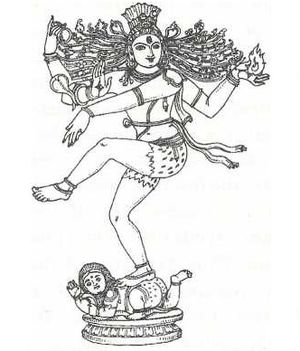Naṭarāja
By Swami Harshananda
Worship of Śiva[edit]
Śiva, Devī and Viṣṇu are the three aspects of the Supreme Lord. They are most commonly worshiped by the people even today. Though Śiva is generally worshiped in the temples in the aniconic form, the liṅga, iconic forms are also common. They are mostly depicted on the walls and niches outside the sanctum.
Classification of Iconic Form of Śiva[edit]
These iconic forms are generally divided into eight categories. Among these categories Nṛtta or Tāṇḍava murtis are also the one. Treatises on dancing describe 108 modes of dancing, all attributed to Śiva as the originator. However, out of the nine modes which are more well-known and popular, the Natarāja aspect is the best.
First Reference of Naṭarāja[edit]
The earliest idea of Śiva as the dancer can be traced in the Śivasutras,[1] a cardinal text of Kashmir Śaivism.
The earliest use of the name ‘Naṭarāja’ appears in the Nandikeśvara on the Māheśvarasūtras of the Panini. There he mentions that Śiva sounded his ḍamaru[2] fourteen times at the end of his dance, producing fourteen sound patterns which are now called Māheśvarasūtras like a, i uṇ and so on. These sound patterns form the basic structure of the entire Sanskrit grammar.
Portrayal of Naṭarāja Image[edit]
The Naṭarāja icon shows him with four hands and two legs in the posture of dancing. There is a ḍamaru[3] in the upper right hand and fire in the left. The lower right hand is in the abhayamudrā[4] and the left is pointing towards the uplifted left foot. The right is resting on the demon Apasmāra-puruṣa. The whole image might be surrounded by the circle of blazing fire.
Significance of Naṭarāja[edit]
It Signifies the following:
- Śiva's dance indicate a continuous process of creation, preservation and destruction.
- The ḍamaru represents the principle of śabda.
- It also represents the ākaṣa which proceeds immediately from the ātman.
- It is responsible for further creation or evolution.
- Fire represents pralayāgni, the fire that destroys the world at the time of dissolution of the world and hence symbolizes the process of destruction. Thus ḍamaru and fire represent the continuous cycle of creation, preservation and destruction.
- The other two hands indicate that he who take refuge at the feet of Lord will have nothing to fear.
- The Apasmāra-puruṣa[5] symbolizes ignorance which makes us lose our balance and consciousness. He is trampled upon by the Lord for the betterment of devotees who take refuge in him.
References[edit]
- The Concise Encyclopedia of Hinduism, Swami Harshananda, Ram Krishna Math, Bangalore

